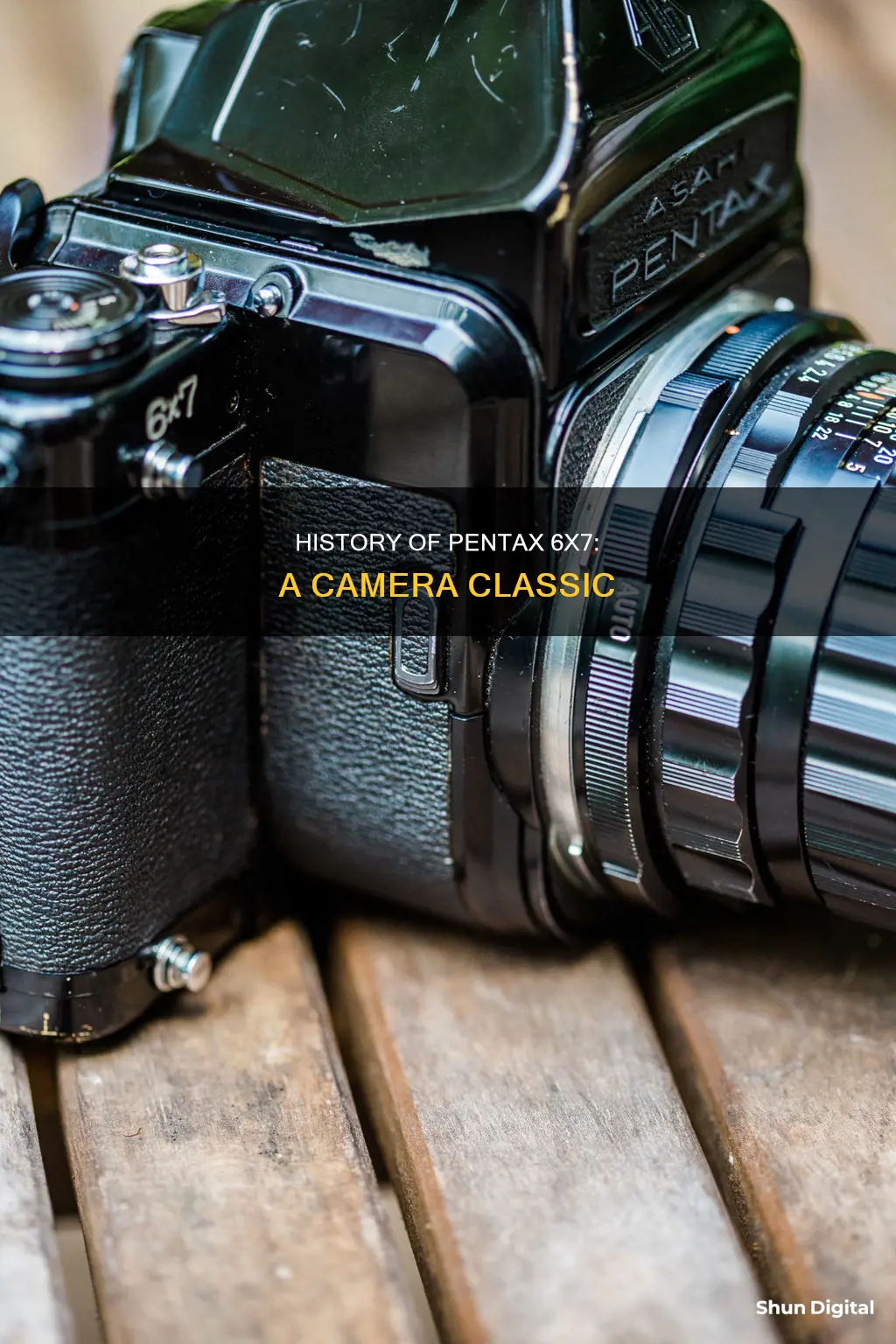
The Pentax 6x7, also known as the Pentax 67, is a medium-format camera produced by Asahi Pentax. The original model was launched in 1969, with subsequent models released in 1976, 1989, and 1998. The camera is known for its large size and weight, resembling a conventional 35mm SLR camera but considerably bigger. It uses 120 and 220 film and produces images that are 6cm by 7cm in size. The Pentax 6x7 has a dual bayonet lens mount and a wide range of interchangeable lenses, making it a versatile and popular choice for photographers despite its bulk.
| Characteristics | Values |
|---|---|
| Original Name | Pentax 6x7 |
| Alternative Name | Pentax 67 (since 1990) |
| Prototype Name | Pentax 220 |
| Prototype Release Date | 1965 |
| Release Date | 1969 |
| Manufacturer | Asahi Pentax |
| Type of Camera | SLR medium format system film camera |
| Film Type | 120 and 220 |
| Image Size | 6 cm by 7 cm (56mm by 70mm in the film gate) |
| Weight | 2.3 kilograms (5.1 lb) with the plain prism and standard (105 mm f/2.4) lens |
| Lens Mount | Dual bayonet lens mount |
| Lens Type | Interchangeable Takumar and later SMC Pentax 67-designated lenses |
| Models | Asahi Pentax 6x7 (first generation); Asahi Pentax 6x7 (MLU) with a mirror lock-up mechanism (second generation); Pentax 67 (third generation); Pentax 67 II (fourth generation) |
What You'll Learn

The Pentax 6x7 was first released in 1969
The Pentax 6x7 has a dual bayonet lens mount and a wide range of interchangeable Takumar and later SMC Pentax 67-designated lenses. The standard Pentax 6x7 outfit typically includes a non-metered pentaprism and a Super Takumar 105mm f/2.4 lens. The camera has a dual Pentax bayonet lens mount, with the inner mount for lenses with a focal length from 35mm to 300mm and the outer mount for lengths of 400mm to 1000mm.
The Pentax 6x7 is a Japanese medium-format SLR roll film camera by Asahi Pentax. Pentax's plans for a 6x7 SLR date back to around 1960, but the camera's development faced challenges, including changing from a mechanical to an electronic shutter and adjusting the camera for 220 film use. In 1966, the camera was presented in prototype form as the Pentax 220 at Photokina, and it was finally released in 1969 with an all-black finish.
The body of the Pentax 6x7 is in the style of an oversized 35mm SLR camera, sometimes referred to as a "super SLR". The camera is completely battery-dependent, using a 6V PX28/4LR44 battery, and does not have a built-in exposure meter. The film transport uses a single-stroke film advance wind lever, and the film automatically stops at the correct frame. The film counter is located on top of the advance lever.
The original Pentax 6x7 was succeeded by several improved models, including the Pentax 6x7 (MU) in 1976, which featured a mirror lock-up function, and the Pentax 67 in 1989, which had minor cosmetic updates and improved metering. The final model in the series, the Pentax 67II, was released in 1998 and offered several notable improvements, including a built-in right-hand grip and an AE finder that allowed for aperture-priority semi-auto exposure mode.
Latest Camera Raw: What's New in the Update?
You may want to see also

It was renamed the Pentax 67 in 1990
The Pentax 6x7 camera was first introduced in 1969 as a Japanese medium-format SLR roll film camera by Asahi Pentax. In 1990, the camera received a series of minor engineering updates and cosmetic changes and was renamed the Pentax 67.
The third version of the camera, the Pentax 67, was released in 1989, a year before its renaming. This version featured minor cosmetic updates, including changing the branding from "6X7" to "67". Despite the new name, the Pentax 67 remained compatible with all accessories, lenses, and prisms from previous models.
The most notable improvement in the Pentax 67 was the upgraded metering prism, which replaced the old CdS cell with a more responsive silicon photo diode. This enhanced the camera's metering capabilities while keeping the metering range unchanged.
The renaming of the camera from Pentax 6x7 to Pentax 67 in 1990 reflected the minor updates and improvements made to the third version of the camera, ensuring that its name aligned with the latest iteration of the product.
The Pentax 67 marked a transition point in the evolution of the camera, paving the way for future iterations like the Pentax 67II, which was released in 1998 and offered further enhancements to the system.
Mastering Camera Raw: Adjusting Clarity for Stunning Photos
You may want to see also

The camera is a medium-format SLR
The Pentax 6x7 is a single-lens reflex (SLR) medium-format film camera, first introduced in 1969 and produced in various iterations until it was discontinued in 2009. The camera uses 120 film and exposes images on a 6x7cm area, hence the name. The camera was also able to use 220 film, though this is no longer manufactured.
The Pentax 6x7 is a system camera, which means it has interchangeable lenses, prisms, and accessories. The standard kit typically features a lens of around 105mm, a viewing prism (eye-level, waist-level, or with a metering head), and a wooden handle that can be placed on either side of the body.
The camera is large and heavy, weighing around 5lbs, and resembling a conventional 35mm SLR camera but considerably bigger. It has a dual bayonet lens mount and a wide range of interchangeable Takumar and SMC Pentax 67-designated lenses. The camera is battery-powered and completely dependent on this power source to operate.
There were four models of the Pentax 6x7 released over time:
- The original Asahi Pentax 6x7, launched in 1969
- The Asahi Pentax 6x7 (MLU), with a mirror lock-up mechanism, launched in 1976
- The Pentax 67, with minor cosmetic changes and improved metering prism, launched in 1989
- The Pentax 67 II, the final iteration with major improvements including a rigid right-hand grip, modern flash connector, improved long exposure capability, and an LCD panel, launched in 1998 or 1999
Leica's Golden Cameras: A Limited Edition Run
You may want to see also

It has a dual bayonet lens mount
The Pentax 6x7 (called "Pentax 67" after 1990) is a medium-format camera that supports a dual bayonet lens mount. This mount is located at the front of the mirror housing and allows for both an "inner" and an "outer" bayonet arrangement.
The "inner" bayonet is a familiar 3-flange proprietary arrangement. On the other hand, the "outer" bayonet is a 4-flange symmetrical arrangement provided for use with larger and heavier telephoto lenses. This outer mount allows the body to rotate and lock in any of the four positions.
Due to the rotatable mounting of the outer bayonet, lenses mounted on it will not have "automatic aperture" linkage. This means that the aperture will have to be used as a stop-down method of operation.
Creating Camera Raw Profiles: A Step-by-Step Guide
You may want to see also

The camera is battery-dependent
The Pentax 6x7 is a camera that was first introduced in 1969 and produced in various iterations until 2009. The camera is battery-dependent, and while its mirror and cloth curtains are mechanically driven, the timing of the shutter is electrically governed by transistors and a magnet. This means that a battery is required to power the timing of the shutter and to hold the curtain release mechanism when the release button is pressed.
The original battery for the Pentax 6x7 was a 6-volt PX28 battery, which was specified for mercury in 1968 and for silver oxide in 1971. However, there are equivalent batteries that can be used as a replacement, such as the 4LR44 and 4SR44. The 4LR44 is an alkaline battery, while the 4SR44 is a silver-oxide battery that keeps a more stable voltage, does not corrode, and lasts longer but is also more expensive.
It is important to note that leaving a battery inside the camera when it is not in use can lead to corrosion and a dead camera. Additionally, if the battery dies while on a trip, it is possible to stack four MS76 batteries together with transparent tape to create a temporary replacement.
The Pentax 6x7 also has a mirror lock-up mechanism that can be activated by sliding a switch on the right-hand side, just behind the lens mount. This feature eliminates mirror-slap vibration for low-light and long-exposure shooting. However, it is important to tape over the MLU nib when the camera is not in use, as bumping it can cause the battery to flatten.
In summary, the Pentax 6x7 is a battery-dependent camera that requires a specific type of battery for its shutter mechanism to function properly. There are equivalent batteries available, but leaving the battery inside the camera or bumping the MLU nib can cause issues.
Reducing Grain in Camera Raw: Tips for Sharper Photos
You may want to see also







